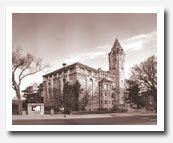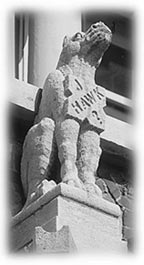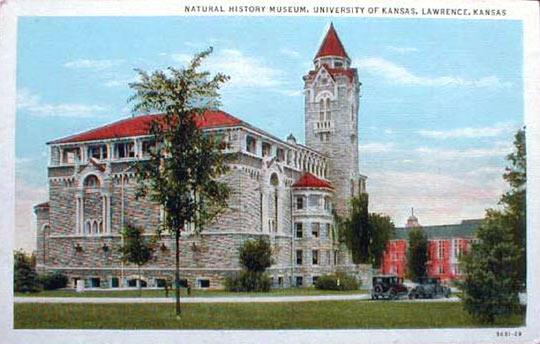Chancellor Francis Snow made annual requests to the legislature to construct a building to house the university's burgeoning natural history collections starting in 1892. Lewis Lindsay Dyche, a KU professor whose animal panorama exhibited at the 1893 World's Columbian exhibition made him nationally famous, campaigned for the museum, finally funded in 1901.
 The architects designed the building in the Romanesque style of southern France, with an entryway after St. Trophime in Arles. They replaced religious iconography with all manner of birds, beasts, and reptiles, to represent the collections inside. L.L. Dyche planned the interior spaces, with a large room to show off his Panorama. The native limestone building with it's distinctive tower and dignified exterior remains not only
The architects designed the building in the Romanesque style of southern France, with an entryway after St. Trophime in Arles. They replaced religious iconography with all manner of birds, beasts, and reptiles, to represent the collections inside. L.L. Dyche planned the interior spaces, with a large room to show off his Panorama. The native limestone building with it's distinctive tower and dignified exterior remains not only  the most beautiful building on campus, but one of the few still used for its original purpose. It was named for L.L. Dyche upon his death in 1915. the most beautiful building on campus, but one of the few still used for its original purpose. It was named for L.L. Dyche upon his death in 1915.
Closed for major interior structural renovations from 1932 to 1941, the building has had two major additions; a seven-story wing in 1963 and a fireproof facility for specimens stored in alcohol in 1995.
Dyche Hall was placed on the National Register of Historic Places in 1973 and celebrated its centennial in 2003. The seven million specimens in the collection, as well as research facilities and offices, now known as the Natural History Museum and Biodiversity Research Center, are housed in Dyche Hall and spill over into five other campus buildings.
Back Next
|
 |
|
Location:
Jayhawk Boulevard
Opened:
1903
Architect:
Root and Siemens, Kansas City MO
Contractor:
Henry Bennett, Topeka KS
Sculptor:
Joseph Robleto Frazee, assisted by son Vitruvius and KU students
Levels:
Five
Exterior walls, foundation:
Oread limestone quarried on site, coursed; trim limestone from Cottonwood Falls
Structure:
Reinforced concrete
Roof:
Red clay flat tile; hip; boxed bracketed cornice
Window surrounds:
Limestone lintels and lugsills on bay windows, engaged columns on some others
Door surrounds:
Glass transom recessed from semicircular arch and pediments resting on six columns
Trim:
Balconies, belt lines, pediments, entablature, arcading, red brick corbelling, grotesques, decorative animals
Tower:
Six stories surmounted by open cupola |
|
